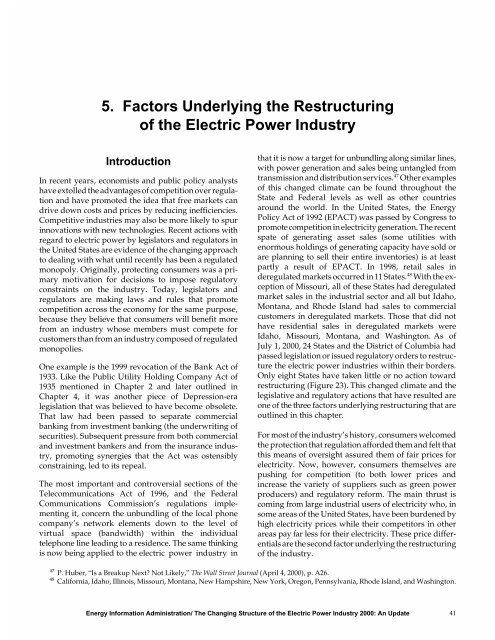The Changing Structure of the Electric Power Industry 2000: An ... - EIA
The Changing Structure of the Electric Power Industry 2000: An ... - EIA
The Changing Structure of the Electric Power Industry 2000: An ... - EIA
You also want an ePaper? Increase the reach of your titles
YUMPU automatically turns print PDFs into web optimized ePapers that Google loves.
5. Factors Underlying <strong>the</strong> Restructuring<br />
<strong>of</strong> <strong>the</strong> <strong>Electric</strong> <strong>Power</strong> <strong>Industry</strong><br />
Introduction<br />
In recent years, economists and public policy analysts<br />
have extolled <strong>the</strong> advantages <strong>of</strong> competition over regulation<br />
and have promoted <strong>the</strong> idea that free markets can<br />
drive down costs and prices by reducing inefficiencies.<br />
Competitive industries may also be more likely to spur<br />
innovations with new technologies. Recent actions with<br />
regard to electric power by legislators and regulators in<br />
<strong>the</strong> United States are evidence <strong>of</strong> <strong>the</strong> changing approach<br />
to dealing with what until recently has been a regulated<br />
monopoly. Originally, protecting consumers was a primary<br />
motivation for decisions to impose regulatory<br />
constraints on <strong>the</strong> industry. Today, legislators and<br />
regulators are making laws and rules that promote<br />
competition across <strong>the</strong> economy for <strong>the</strong> same purpose,<br />
because <strong>the</strong>y believe that consumers will benefit more<br />
from an industry whose members must compete for<br />
customers than from an industry composed <strong>of</strong> regulated<br />
monopolies.<br />
One example is <strong>the</strong> 1999 revocation <strong>of</strong> <strong>the</strong> Bank Act <strong>of</strong><br />
1933. Like <strong>the</strong> Public Utility Holding Company Act <strong>of</strong><br />
1935 mentioned in Chapter 2 and later outlined in<br />
Chapter 4, it was ano<strong>the</strong>r piece <strong>of</strong> Depression-era<br />
legislation that was believed to have become obsolete.<br />
That law had been passed to separate commercial<br />
banking from investment banking (<strong>the</strong> underwriting <strong>of</strong><br />
securities). Subsequent pressure from both commercial<br />
and investment bankers and from <strong>the</strong> insurance industry,<br />
promoting synergies that <strong>the</strong> Act was ostensibly<br />
constraining, led to its repeal.<br />
<strong>The</strong> most important and controversial sections <strong>of</strong> <strong>the</strong><br />
Telecommunications Act <strong>of</strong> 1996, and <strong>the</strong> Federal<br />
Communications Commission’s regulations implementing<br />
it, concern <strong>the</strong> unbundling <strong>of</strong> <strong>the</strong> local phone<br />
company’s network elements down to <strong>the</strong> level <strong>of</strong><br />
virtual space (bandwidth) within <strong>the</strong> individual<br />
telephone line leading to a residence. <strong>The</strong> same thinking<br />
is now being applied to <strong>the</strong> electric power industry in<br />
that it is now a target for unbundling along similar lines,<br />
with power generation and sales being untangled from<br />
transmission and distribution services. 47 O<strong>the</strong>r examples<br />
<strong>of</strong> this changed climate can be found throughout <strong>the</strong><br />
State and Federal levels as well as o<strong>the</strong>r countries<br />
around <strong>the</strong> world. In <strong>the</strong> United States, <strong>the</strong> Energy<br />
Policy Act <strong>of</strong> 1992 (EPACT) was passed by Congress to<br />
promote competition in electricity generation. <strong>The</strong> recent<br />
spate <strong>of</strong> generating asset sales (some utilities with<br />
enormous holdings <strong>of</strong> generating capacity have sold or<br />
are planning to sell <strong>the</strong>ir entire inventories) is at least<br />
partly a result <strong>of</strong> EPACT. In 1998, retail sales in<br />
deregulated markets occurred in 11 States. 48 With <strong>the</strong> exception<br />
<strong>of</strong> Missouri, all <strong>of</strong> <strong>the</strong>se States had deregulated<br />
market sales in <strong>the</strong> industrial sector and all but Idaho,<br />
Montana, and Rhode Island had sales to commercial<br />
customers in deregulated markets. Those that did not<br />
have residential sales in deregulated markets were<br />
Idaho, Missouri, Montana, and Washington. As <strong>of</strong><br />
July 1, <strong>2000</strong>, 24 States and <strong>the</strong> District <strong>of</strong> Columbia had<br />
passed legislation or issued regulatory orders to restructure<br />
<strong>the</strong> electric power industries within <strong>the</strong>ir borders.<br />
Only eight States have taken little or no action toward<br />
restructuring (Figure 23). This changed climate and <strong>the</strong><br />
legislative and regulatory actions that have resulted are<br />
one <strong>of</strong> <strong>the</strong> three factors underlying restructuring that are<br />
outlined in this chapter.<br />
For most <strong>of</strong> <strong>the</strong> industry’s history, consumers welcomed<br />
<strong>the</strong> protection that regulation afforded <strong>the</strong>m and felt that<br />
this means <strong>of</strong> oversight assured <strong>the</strong>m <strong>of</strong> fair prices for<br />
electricity. Now, however, consumers <strong>the</strong>mselves are<br />
pushing for competition (to both lower prices and<br />
increase <strong>the</strong> variety <strong>of</strong> suppliers such as green power<br />
producers) and regulatory reform. <strong>The</strong> main thrust is<br />
coming from large industrial users <strong>of</strong> electricity who, in<br />
some areas <strong>of</strong> <strong>the</strong> United States, have been burdened by<br />
high electricity prices while <strong>the</strong>ir competitors in o<strong>the</strong>r<br />
areas pay far less for <strong>the</strong>ir electricity. <strong>The</strong>se price differentials<br />
are <strong>the</strong> second factor underlying <strong>the</strong> restructuring<br />
<strong>of</strong> <strong>the</strong> industry.<br />
47 P. Huber, “Is a Breakup Next? Not Likely,” <strong>The</strong> Wall Street Journal (April 4, <strong>2000</strong>), p. A26.<br />
48 California, Idaho, Illinois, Missouri, Montana, New Hampshire, New York, Oregon, Pennsylvania, Rhode Island, and Washington.<br />
Energy Information Administration/ <strong>The</strong> <strong>Changing</strong> <strong>Structure</strong> <strong>of</strong> <strong>the</strong> <strong>Electric</strong> <strong>Power</strong> <strong>Industry</strong> <strong>2000</strong>: <strong>An</strong> Update 41

















